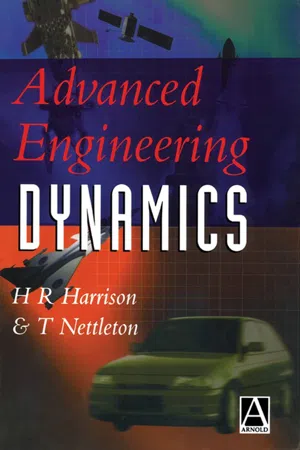
- 320 pages
- English
- ePUB (mobile friendly)
- Available on iOS & Android
Advanced Engineering Dynamics
About This Book
'Advanced Engineering Dynamics' bridges the gap between elementary dynamics and advanced specialist applications in engineering.It begins with a reappraisal of Newtonian principles before expanding into analytical dynamics typified by the methods of Lagrange and by Hamilton's Principle and rigid body dynamics. Four distinct vehicle types (satellites, rockets, aircraft and cars) are examined highlighting different aspects of dynamics in each case. Emphasis is placed on impact and one dimensional wave propagation before extending the study into three dimensions. Robotics is then looked at in detail, forging a link between conventional dynamics and the highly specialised and distinctive approach used in robotics. The text finishes with an excursion into the Special Theory of Relativity mainly to define the boundaries of Newtonian Dynamics but also to re-appraise the fundamental definitions. Through its examination of specialist applications highlighting the many different aspects of dynamics this text provides an excellent insight into advanced systems without restricting itself to a particular discipline. The result is essential reading for all those requiring a general understanding of the more advanced aspects of engineering dynamics.
Frequently asked questions
Information
Newtonian Mechanics
1.1 Introduction
1.2 Fundamentals
Table of contents
- Cover image
- Title page
- Table of Contents
- Copyright
- Dedication
- Preface
- Chapter 1: Newtonian Mechanics
- Chapter 2: Lagrange’s Equations
- Chapter 3: Hamilton’s Principle
- Chapter 4: Rigid Body Motion in Three Dimensions
- Chapter 5: Dynamics of Vehicles
- Chapter 6: Impact and One-Dimensional Wave Propagation
- Chapter 7: Waves In a Three-Dimensional Elastic Solid
- Chapter 8: Robot Arm Dynamics
- Chapter 9: Relativity
- Problems
- Appendix 1: Vectors, Tensors and Matrices
- Appendix 2: ANALYTICAL DYNAMICS
- Appendix 3: Curvilinear co-ordinate systems
- Bibliography
- Index